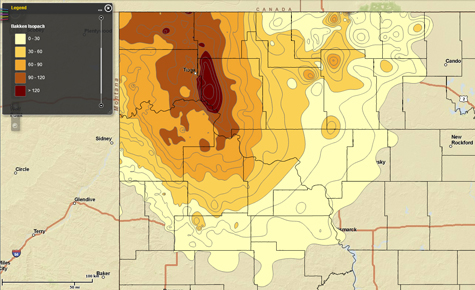Geology
The Bakken Formation comprises three distinct members. The upper and lower members are black, organic-rich shales and are widely recognized as world-class source rocks. These members also serve as very effective seals, owing to their very low permeability. Permeability ranges from 0.01–20 mD. The middle member is the primary oil-producing member and predominantly composed of siltstones and sandstones but also has low porosity (1%-15%) and permeability (0-20 millidarcies),2 particularly for a reservoir rock.
Because of the strong contrast in lithology, the Bakken Formation is readily recognizable in wireline logs. The upper and lower shales have unusually high gamma ray readings and high resistivity, while the middle member has a signature similar to clastic and carbonate rocks.2
Thickness
Current oil production activity has focused on the middle member as well as the underlying Three Forks Formation.
The thickest area of the Bakken Formation is southeast of Tioga, North Dakota, T. 155N., R. 94W., Section 15, where it reaches 145–150 feet.
This area is located at the eastern base of the Nesson Anticline. The formation generally thins evenly toward the margins
of the Williston Basin. The middle and lower members of the Bakken share a similar isopachous trend (maximum thickness 75
and 55 feet, respectively); however, the upper shale demonstrates distributed areas of maximum thickness near the eastern
and southern marginal shelf in North Dakota, in addition to maximum thickness near Tioga.
The overlying Lodgepole Formation consists of dense limestone and calcareous shale with minor amounts of chert and anhydrite,
with a maximum thickness of 900 feet in eastern McKenzie, North Dakota. The Bakken is underlain by the Three Forks Formation, which
has a maximum thickness of 250 feet in eastern McKenzie County. The Three Forks Formation consists of shales, dolostones, siltstones,
sandstones, and minor occurrences of anhydrite.


